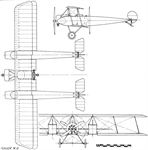
Описание
Страна: Германия
Год: 1915
Fighter
A.Weyl Fokker: The Creative Years (Putnam)
While the M.7 was giving so much trouble, Fokker was doing some thinking about fighting in the air. Firms were encouraged to fit a machinegun to the observer’s cockpit of their two-seat types. Such armament was purely defensive; what was needed was an offensive fighter aircraft.
Fokker decided to build such an aircraft without official guidance or advice. He confidently expected to achieve quick results by using components of existing types.
Two M.7 fuselage structures, engineless but each with its individual standard tail group, were joined by a biplane structure. Between these fuselages a nacelle was mounted centrally on the lower wing. In this the pilot sat, sandwiched between two 80-h.p. Oberursel rotaries, one driving a tractor airscrew, the other a pusher. Outboard of the fuselages the equal-span wings had two-bay bracing. Two gunners were to be carried, one in the front of each fuselage; no armament was ever fitted, however, and there was no provision for rearward defence.
By the standards of its time the basic idea of the Fokker M.9 was reasonably promising, and the aircraft might have proved better than the A.E.G. K.I, apart from its lack of rear defence. But the execution of this interesting experiment was utterly unsatisfactory. It was a makeshift, hastily assembled without any attempt at engineering; and its tests by Fokker were correspondingly slapdash.
For the first take-off, six men were posted along the intended run armed with fire extinguishers; others sat in two motor-cars and on motorcycles with engines running, ready to rescue the pilot in the event of mishap. The take-off run was rather long. On landing, Fokker complained that the fuselages moved when the wings were warped. He made another flight alone, and finally took up two passengers (military mechanics) in the gunners’ positions in an attempt to correct the M.9’s tail-heaviness. Henze recalls that all these flights took place within the space of a few days and were quite short.
After this perfunctory testing of a radical new design Fokker gave up. The M.9 was put aside for dismantling, and its development was completely abandoned. Any aeronautical engineer could have foreseen that the lack of any rear connexion between the fuselages would permit flexing and lead to unsatisfactory control. If Fokker had had more patience he might have made something of the M.9. However, his attention was then fully taken up by the work on the M.5K/MG single-seat fighter, which began when the M.9 was abandoned.
Описание:
- A.Weyl Fokker: The Creative Years (Putnam)
- J.Herris Fokker Aircraft of WWI. Vol.1: Spinne - M.10 & Watercraft (A Centennial Perspective on Great War Airplanes 51)
- O.Thetford, P.Gray German Aircraft of the First World War (Putnam)
- W.Green, G.Swanborough The Complete Book of Fighters
Фотографии
-
J.Herris - Fokker Aircraft of WWI. Vol.1: Spinne - M.10 & Watercraft /Centennial Perspective/ (51)
The fully assembled Fokker M.9. The M.8 fuselages were connected to a central nacelle with a center section that was unique to the M.9. (Peter M. Grosz collection/STDB)
-
J.Herris - Fokker Aircraft of WWI. Vol.1: Spinne - M.10 & Watercraft /Centennial Perspective/ (51)
The unusual Fokker M.9 prototype was developed as an airplane that could defend itself against attack by other aircraft. (Peter M. Grosz collection/STDB)
-
J.Herris - Fokker Aircraft of WWI. Vol.1: Spinne - M.10 & Watercraft /Centennial Perspective/ (51)
Close-up of the completed Fokker M.9. The nacelles for the gunners are at the front of the twin booms. Power was provided by two 80 hp Oberursel U.0 engines mounted as a tractor and pusher. (Peter M. Grosz collection/STDB)
-
J.Herris - Fokker Aircraft of WWI. Vol.1: Spinne - M.10 & Watercraft /Centennial Perspective/ (51)
The partially assembled Fokker M.9 being towed by a car. The M.8 fuselages were connected to a central nacelle with a center section that was unique to the M.9. (Peter M. Grosz collection/STDB)
For towing, a transverse bar was attached to both fuselages of the M.9. -
J.Herris - Fokker Aircraft of WWI. Vol.1: Spinne - M.10 & Watercraft /Centennial Perspective/ (51)
M.9 under construction in the Fokker factory. (Peter M. Grosz collection/STDB)
-
A.Weyl - Fokker: The Creative Years /Putnam/
Fokker M.9












